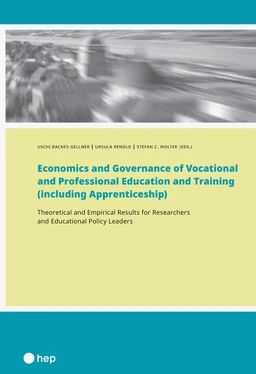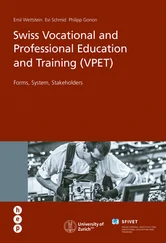
Uschi Backes-Gellner, Ursula Renold, Stefan C. Wolter (eds.) [1]
Economics and Governance of Vocational and Professional Education and Training (including Apprenticeship)
Theoretical and Empirical Results for Researchers and Educational Policy Leaders
ISBN Print: 978-3-0355-1677-7
ISBN E-Book: 978-3-0355-1678-4
Titelgrafik: © ETH Zürich/Gian Marco Castelberg
1. Auflage 2020
Alle Rechte vorbehalten
© 2020 hep Verlag AG, Bern
hep-verlag.com
Table of Content
Chapter 1:Introduction
Uschi Backes-Gellner, Ursula Renold, Simone Tuor Sartore, Stefan C. Wolter
Chapter 2:Socially Constructed Concepts—Methodological Problems in Comparing VET Programs
Ursula Renold
Chapter 3:Firms
Stefan C. Wolter
3.1Net Costs of Training Apprentices and the Willingness to Train
Stefan C. Wolter, Samuel Muehlemann, Juerg Schweri
3.2The Number of Competitors Increases the Net Costs of Training Apprentices
Samuel Muehlemann, Paul Ryan, Stefan C. Wolter
3.3Net Costs of Training Apprentices in Different Systems
Regina Dionisius, Samuel Muehlemann, Harald Pfeifer, Guenter Walden, Felix Wenzelmann, Stefan C. Wolter
3.4Employers’ Strategies to Apprenticeship Training: Investment or Production
Jens Mohrenweiser, Uschi Backes-Gellner
3.5The Willingness to Train for Companies with Net Costs is Slowed Down by Poaching
Samuel Muehlemann, Stefan C. Wolter
3.6Retaining Apprenticeship Graduates
Jens Mohrenweiser, Thomas Zwick, Uschi Backes-Gellner
3.7Net Costs, Hiring Costs, and the Willingness to Train
Marc Blatter, Samuel Muehlemann, Samuel Schenker, Stefan C. Wolter
3.8University Graduates Profit from Working Together with VET Graduates
Uschi Backes-Gellner, Christian Rupietta, Simone N. Tuor Sartore
3.9Avoiding Labor Shortages by Improving Recruitment Success Through Apprenticeship Training
Uschi Backes-Gellner, Simone N. Tuor
3.10How Firms’ Participation in Apprenticeship Training Contributes to Innovation
Christian Rupietta, Uschi Backes-Gellner
3.11How Does Diversity of Employees in Terms of Formal Education Degrees Affect Firm Innovation?
Thomas Bolli, Ursula Renold, Martin Woerter
3.12Ongoing Research Firms
Stefan C. Wolter
Chapter 4:Individuals
Uschi Backes-Gellner
4.1Recruitment Decision of Firms
Barbara Mueller, Stefan C. Wolter
4.2Learning for a Bonus in Vocational Education and Training
Yvonne Oswald, Uschi Backes-Gellner
4.3Transition from Vocational Education and Training into the Labor Market
Kathrin Bertschy, M. Alejandra Cattaneo, Stefan C. Wolter
4.4Vocational Versus Academic Tertiary Education
Uschi Backes-Gellner, Regula Geel
4.5Why Permeability Counts?
Simone N. Tuor, Uschi Backes-Gellner
4.6Are the Returns to Education the Same for Everyone? A Look at Wage Distribution
Simone Balestra, Uschi Backes-Gellner
4.7Specificity of VET Occupations and Mobility
Regula Geel, Johannes Mure, Uschi Backes-Gellner
4.8Occupational Mobility Within and Between Clusters of Occupations
Regula Geel, Uschi Backes-Gellner
4.9Specific Occupations Promise Higher Wages When Staying, While General Occupations Enhance Occupational Mobility
Christian Eggenberger, Miriam Rinawi, Uschi Backes-Gellner
4.10When Skills Lose Value over Time: Workplace Tasks and Skill Obsolescence
Simon Janssen, Uschi Backes-Gellner
4.11Ongoing Research Individuals
Uschi Backes-Gellner
Chapter 5:State and Institutional Frameworks
Ursula Renold
5.1How Can Scholars Develop an Explanatory Typology of VET Programs?
Ladina Rageth, Ursula Renold
5.2KOF EELI: Measuring Education-Employment Linkage
Thomas Bolli, Katherine Marie Caves, Ursula Renold, Jutta Buergi
5.3Which Skills Can Best be Learned in the Workplace?
Thomas Bolli, Ursula Renold
5.4Labor Market Regulation and Its Impact on Apprenticeship Training
Samuel Muehlemann, Harald Pfeifer, Guenter Walden, Felix Wenzelmann, Stefan C. Wolter
5.5Labor Market Deregulation and Its Impact on Apprenticeship Training
Anika Jansen, Mirjam Strupler Leiser, Felix Wenzelmann, Stefan C. Wolter
5.6Policy Preferences of Voters Concerning Academic vs. Vocational Education
Marius R. Busemeyer, M. Alejandra Cattaneo, Stefan C. Wolter
5.7Is Vocational Education and Training Only the First Choice for Those Rooted in Such a System?
Aurélien Abrassart, Marius R. Busemeyer, Maria A. Cattaneo, Stefan C. Wolter
5.8State Interventions to Promote Vocational Education and Training
Mirjam Strupler Leiser, Stefan C. Wolter
5.9Ongoing Research State and Institutional Frameworks
Ursula Renold
Chapter 6:Monitoring the Youth Labour Market Situation Around the Globe
Ursula Renold, Thomas Bolli, Maria Esther Oswald-Egg, Filippo Pusterla
Appendix A: Glossary
Appendix B: Further Readings on PVET
Uschi Backes-Gellner, Ursula Renold, Simone Tuor Sartore, Stefan C. Wolter
Worldwide attention has recently turned to Vocational Education and Training (VET) in general and to countries with well-functioning Vocational and Professional Education and Training (VPET) systems in particular. This interest is due to these countries’ better youth employment rates and closer links between their education systems and the employment systems. Moreover, this interest particularly applies to countries with “dual VET” or VET that takes place largely within training firms (referred to in this book as “apprenticeship training”), with the rest in Vocational Schools. Both of the two parts of dual VET follow the same well-defined and highly coordinated curriculum for each occupation.
However, little research from an economics, management, or governance perspective has focused on the preconditions of a successful VPET system. Although some economic models and theories had been developed in the 1960s and 1970s (Becker, 1962, 1964), economists started to analyze dual VET more in detail only at the end of the 1990s (see, e.g., Harhoff & Kane, 1997; Acemoglu & Pischke, 1998), focusing mainly on the poaching problem. However, starting in the late 1980s, dual VET was also analyzed from a management perspective, pointing out reputation effects for firms participating in apprenticeship training (Sadowski, 1980) or optimal inventory strategies for firms training apprentices and thereby investing in an inventory of skilled workers (Backes-Gellner, 1996).
Meanwhile, governance, the role of the state, and the institutional framework of VPET were discussed in the social sciences as early as the late 1980s (Greinert, 1988; Lauterbach, 1995; Ryan, 2000). More recently, research on the economics, management, and governance of VPET in general and of dual VET in particular has increased substantially, with a special focus on countries such as Germany and Switzerland with their dual VPET systems.
This book provides an overview of this research by, first, reprinting a selection of publications that deal with fundamental questions, thereby providing initial theoretical and empirical evidence, and, second, summarizing ongoing research and preliminary results. While concentrating on evidence from Switzerland (and sometimes Germany or other countries), the book also includes international comparative studies and studies of selected countries with evolving VPET systems. In addition to presenting original research papers, this book also provides policy briefs and formulates lessons that other countries can learn if they are interested in implementing or improving their own dual VET systems. As Switzerland and Germany have very different labor market regulations and governance structures—with Switzerland deregulated and Germany regulated—the results presented in this book provide insights for countries with more deregulated or liberal market economies (e.g., Australia, the UK, the U.S.) and for countries with a more coordinated market economy (e.g., Austria, Japan, Sweden).
Читать дальше













